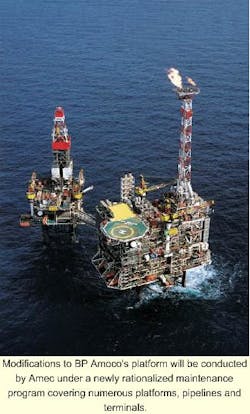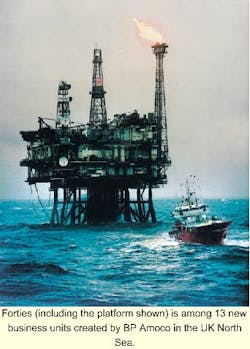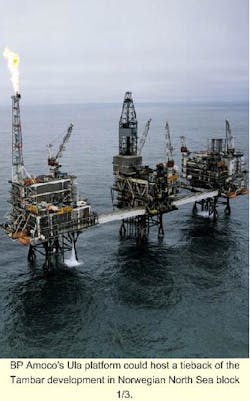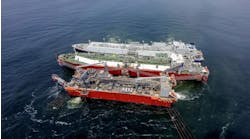Upstream managers of BP Amoco (BPA) gathered recently at an English country house hotel to participate in the latest stage in the remolding of the merged company, including a review of strategy. According to a spokesman, the result was a commitment to the UKCS and Norway for the long-term. Improved productivity, financial performance, and renewal are the drivers, with technology and "doing things differently" seen as the ways to achieve these goals.
Last year, BPA produced 750,000 b/d of oil and 2,061 MMcf/d of gas from its UKCS fields, tantamount to 20% of UK oil and 15% of UK gas. "One of the key issues now," says the spokesman, "is to maintain production at the current levels. To do that we have to bring on new production to offset declining fields. We have to find ways of developing small fields very cheaply and that is going to require different approaches."
In the near term, there are four small potential developments:
- East Foinaven, with 36 million bbl of recoverable oil, could be developed via two wells and a water injector tied back to the Foinaven FPSO west of Shetland.
- Maclure in Block 9/19 could be linked to Harding in Block 9/23b.
- The 21/15 prospect, south of Forties, where a well was drilled in June to appraise a discovery made by Conoco in 1981.
- The Tambar discovery in Norway, close to Ula.
There are numerous other small prospects which could be developed if the economics prove suitable.
Step change in drilling
"We can see some ways in which to move," says the spokesman. "Well costs, for example, have got to come down. There has to be a step change in drilling. Standardization will go some way towards this and we support all the efforts which Crine and the Task Force are concentrating on.
"We know we have to look for innovative ways of doing things, and use every practical form of new technology, so long as it helps to reduce costs. We realize, in this area, that we need to improve access to technology from both small and medium sized enterprises and large companies."
The company has recently endowed, with a $40 million grant, a cross-disciplinary BP Amoco Institute at Cambridge, UK to be ready by late summer 2000. A core focus will be to increase the precision with which the energy industry predicts how oil and gas will flow out of reservoirs and pipes, and to research problems related to multiphase flow.
BP methods
BP's philosophy and methods apparently are driving the new organization. Sir John Browne, Chief Executive, told shareholders "We have decided to work on the basis of a structure and a set of processes which we know have worked in the past. That means we have integrated the Amoco assets and businesses into a system you would recognize as the established BP approach."
A key aspect of this approach is the formation of business assets, a style pioneered by BP several years ago, in which groups of fields are formed into a separate business unit under an asset manager. The current reorganization has resulted in 13 business units. They are: Brae/Miller, Bruce; CATS; CNS Gas (formerly ETAP), including Lomond and Everest; Wytch Farm; Harding; Forties Pipeline System; Gas Marketing; Greater Forties, including Andrew, Montrose and Arbroath; East of Shetland (Magnus, Thistle, NW Hutton; Northern Export Systems, including the Sullom Voe terminal in Shetland; Southern North Sea; UK Exploration; and West of Shetland.
The combined portfolio includes stakes in 222 blocks, including 137 fields, stretching from the Atlantic Margin to the Southern gas basin. BPA operates some 33 fields.
Clarifying UK interests
Analyst Wood Mackenzie recently suggested that " Partner pressure, driven by the need for a short-term improvement in operating cost control, may convince the super-majors to either relinquish day-to-day operatorship or even undertake the speedy rationalization of non-core holdings to others who may be better focused to take up the fight."
Clearly, there will be some clearing out of this conglomerate. The recent move by the UK government to reinstate capital gains tax rollover relief for the transfer and sale of offshore licensed interests will provide a much needed incentive for operators to rationalize their investment portfolios.
There will be disposals, swaps and, perhaps, handing over of field operations to contractors or other operators.
One possibility under study is regionalization, a concept in which the operator holding the majority of producing fields in one area would assume operatorship of all the fields. Miller, in Block 16/7b, is BPA's sole field in this area. Marathon's Brae complex, to which Miller oil flows, covers a number of blocks in Quadrant 16 and it could be that Marathon would assume responsibility for all the fields.
Some of the fields in the combined portfolio will reach their life's end. It is expected that the 16-year old NW Hutton Field, for example, will cease production next year, to be followed by Thistle in 2002-2003.
Exploration cut
BPA's worldwide exploration and production capex has been cut this year by 40%, to $3.6 billion, and exploration costs have been reduced by $450 million, with exploration activity focused on areas where large, low-cost resources can be found.
Clearly, the North Sea does not loom large in this profile. BPA believes that all the large structures have been discovered. In fact, this year it has only two exploration wells lined up - one west of Shetlands and one to the south of Forties. But it is awaiting with interest the new West of Shetlands and 1st Faroese licensing rounds.
Last year, Shell commented in its "Profit and Principles" report: "We had looked in the mirror and we neither recognized nor liked some of what we saw. We have set about putting it right." BPA also looked in the mirror in the vital area of procurement for its UK operations and decided that a revolutionary change in strategy was required. At the same time, it also discovered that, according to some contractors, it was not the "perfect" company it had always imagined.
In 1998, BPA spent $2 billion on its North Sea operations, 80% of which was spent with third parties. But it discovered it had no coherent policy for its assets. In some cases, contractors had been allowed to govern the supply chain.
Supply chain changes
BPA determined to make clear to all its contractors that supply chain management was a core competency that would remain within the company. Among the key elements introduced are:
- Regionally based contracts, improved transparency of cost and performance
- Improved access to innovation and technology.
In general, this means that one or two suppliers will be contracted to provide overall services in a particular sphere. Earlier this year, BPA invited engineering contractors to bid for engineering and modification services across its entire UKCS asset portfolio.
This May, just two major, five-year contracts were awarded instead of the original four. Remuneration will be on a risk and reward arrangement.
- Amec will cover the Bruce and Miller platforms, Forties Pipeline System, Southern North Sea gas fields and terminals, the Sullom Voe terminal, the Wytch Farm onshore/offshore field, and the Harding platform.
- Wood Group Engineering's contract covers activities east and west of Shetland, the Greater Forties area, and the Central North Sea gas business units.
- In line with the new supply strategy, Aramak was awarded a contract to provide hotel services on BPA's 24 manned offshore installations in all areas of the UKCS.
- A five-year deal was agreed with Andersen Consulting which expands and extends an outsourcing agreement for the provision of finance and administrative services to include the former Amoco North Sea assets.
- Deutag was selected to provide all platform drilling services. This relates to 13 platforms with drilling facilities and the business units covered include East of Shetland, Greater Forties, Bruce, Miller, and Harding.
Alan Jones, BPA's regional president, Scotland, said "We recognize that SMEs will have a role to play and we are actively in discussion with Deutag on how best to involve progressive SMEs in the provision of platform drilling and maintenance services."
Valhall dilemma
In Norway, before the BP Amoco merger went through, both companies had agreed, with Phillips, on principles of cooperation in such areas as common suppliers of goods and services and sharing of facilities. There remain a number of key decisions to be taken. One concerns the 17-year old Valhall Field (developed, operated by Amoco) where the estimated additional oil reserves have been upgraded from 150 million bbl to 200 million bbl.
There has been some agonizing over whether to proceed with a water injection project. The cost would be NKr2.6 - 2.8 billion, as a drilling package might be have to be added to the planned platform.
Another problem is that the field, located in the chalk zone, has a porosity of up to 50%, which leads to subsidence. Studies are underway to determine whether the waterflood project would cause the existing platforms to sink. If so, this would require expensive jacking procedures within 10-15 years.
Hugo Halvorsen, BPA's Vice President for Resources, says "Our present goal is to achieve a recovery factor of 40-45%, and we're looking ahead optimistically to the planned water injection project. This field is set to remain on stream for at least 25-30 years."
However, BPA would want some fiscal relief before proceeding. Rolf Wilborg, resource management director at the Norwegian Petroleum Directorate, says "It should be possible to make a decision fairly quickly, given the new guidelines for reducing royalty and extending licence periods as outlined in the White Paper this year."
There is also the planned development of the Tambar Field, discovered in Block 1/3,which would be tied back to BPA's Ula platform and could be on stream in spring 2001. It is possible that the redundant 2/4-G riser platform, across which oil and gas from Valhall was delivered to the Ekofisk Tank for export, could be employed as the Tambar production facility. Capital investment for a subsea development would be around NKr 1.1 billion.
It now seems likely that there could be a unified development of the big oil and gas field Skarv (inherited from Amoco) with Statoil's recent c-Fangst discovery, 7 km to the north-east and 20 km south of Norne and 50 km north of Heidrun. BPA currently is drilling a Skarv appraisal well. But any development will be dependent on a gas sales solution and a gas allocation.
Looking ahead, there are the two large deepwater original BP-led discoveries - Luva in Block 6707/10 on the Nyk High in the Voring Basin, and Barden in Block 6305/7 on Ormen Lange South, which is to the south of Norsk Hydro's big gas discovery in Block 6305/1.
Nothing dramatic will happen on Nyk High for some time. It is not a priority for BPA. Data from the BP well and Statoil's well in the adjacent Block 6706/11 are being studied to gain a better understanding of the structures. But, it is gas and there is no infrastructure in the area.
On Barden, applications from several companies have been submitted to the Ministry of Petroleum and Energy for the open acreage in Block 6305/8 to the east. But Norway is now in the middle of its holiday season and no award is likely to be made until this fall. BPA is keen to drill a well on the acreage and hopes to become - when unitization takes place - operator of the whole area, a move likely to be challenged vigorously by Norsk Hydro.






